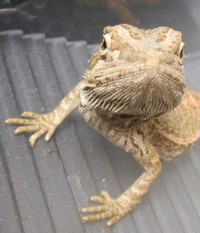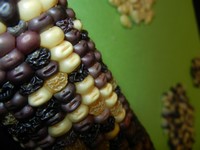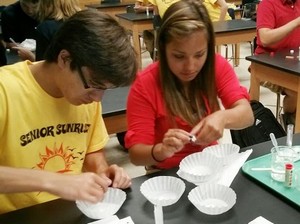 AP Biology
AP Biology
Big Idea 1: Evolution
The process of evolution drives the diversity and unity of life
Enduring Understanding 1.A. Change in the genetic makeup of a population over time is evolution
1.A.1: Natural selection is a major mechanism of evolution
1.A.2: Natural selection acts on phenotypic variations in populations
1.A.3: Evolutionary change is also driven by random processes
1.A.4: Biological evolution is supported by scientific evidence from many disciplines, including mathematics
Enduring Understanding 1.B: Organisms are linked by lines of descent from common ancestry
1.B.1: Organisms share many conserved core processes and features that evolved and are widely distributed among organisms today
1.B.2: Phylogenetic trees and cladograms are graphical representations of evolutionary history that can be tested.
Enduring Understanding 1.C: Life continues to evolve within a changing environment
1.C.1: Speciation and extinction have occurred throughout the Earth's history
1.C.2: Speciation may occur when two populations become reproductively isolated from each other
1.C.3: Populations of organisms continue to evolve
Enduring Understanding 1.D: The origin of living systems is explained by natural processes
1.D.1: There are several hypotheses about the natural origin of life on earth, each with supporting evidence
1.D.2: Scientific evidence from many different disciplines supports models of the origin of life

Sample Learning Objectives
evaluate evidence provided by data to qualitatively and quantitatively investigate the role of natural selection in evolution.
make predictions about the effects of genetic drift, migration and artificial selection on the genetic makeup of a population.
pose scientific questions that correctly identify essential properties of shared, core life processes that provide insights into the history of life on Earth
evaluate evidence provided by a data set in conjunction with a phylogenetic tree or a simple cladogram to determine evolutionary history and speciation
design a plan to answer scientific questions regarding how organisms have changed over time using information from morphology, biochemistry and geology
Big Idea 2: Energy
Biological systems utilize free energy and molecular building blocks to grow, to reproduce, and to maintain dynamic homeostasis
Enduring Understanding 2.A. Growth, reproduction and maintenance of the organization of living systems require free energy and matter
2.A.1: All living systems require constant input of free energy
2.A.2: Organisms capture and store free energy for use in biological processes
2.A.3: Organisms must exchange matter with the environment to grow, reproduce and maintain organization
Enduring understanding 2.B: Growth, reproduction and dynamic homeostasis require that cell create and maintain internal environments that are different from their external environments
2.B.1: Cell membranes are selectively permeable due to their structure
2.B.2: Growth and dynamic homeostasis are maintained by the constant movement of molecules across membranes.
2.B.3: Eukaryotic cells maintain internal membranes that partition the cell into specialized regions
Enduring understanding 2.C: Organisms use feedback mechanisms to regulate growth and reproduction, and to maintain dynamic homeostasis.
2.C.1: Organisms use feedback mechanisms to maintain their internal environments and respond to external environmental changes.
2.C.2: Organisms respond to changes in their external environments.
Enduring understanding 2.D: Growth and dynamic homeostasis of a biological system are influenced by changes in the system’s environment
2.D.1: All biological systems from cells and organisms to populations, communities and ecosystems are affected by complex biotic and abiotic interactions involving exchange of matter and free energy
2.D.2: Homeostatic mechanisms reflect both common ancestry and divergence due to adaptation in different environments
2.D.3: Biological systems are affected by disruptions to their dynamic homeostasis.
2.D.4: Plants and animals have a variety of chemical defenses against infections that affect dynamic homeostasis.
Enduring understanding 2.E: Many biological processes involved in growth, reproduction and dynamic homeostasis include temporal regulation and coordination.
2.E.1: Timing and coordination of specific events are necessary for the normal development of an organism, and these events are regulated by a variety of mechanisms
2.E.2: Timing and coordination of physiological events are regulated by multiple mechanisms.
2.E.3: Timing and coordination of behavior are regulated by various mechanisms and are important in natural selection.

Sample Learning Objectives
explain how biological systems use free energy based on empirical data that all organisms require constant energy input to maintain organization, to grow and to reproduce
predict how changes in free energyavailability affect organisms, populations and ecosystems
construct explanations of the mechanisms and structural features of cells that allow organisms to capture, store or use free energy
use calculated surface area-to-volume ratios to predict which cell(s) might eliminate wastes or procure nutrients faster by diffusion
construct models that connect the movement of molecules across membranes with membrane structure and function
explain how internal membranes and organelles contribute to cell functions.
analyze data to identify possible patterns and relationships between a biotic or abiotic factor and a biological system
The student can create representations and models to describe immune responses
Big Idea 3: Information
Living systems store, retrieve, transmit and respond to information essential to life processes.
Enduring understanding 3.A: Heritable information provides for continuity of life.
3.A.1: DNA, and in some cases RNA, is the primary source of heritable information.
3.A.2: In eukaryotes, heritable information is passed to the next generation via processes that include the cell cycle and mitosis or meiosis plus fertilization.
3.A.3: The chromosomal basis of inheritance provides an understanding of the pattern of passage (transmission) of genes from parent to offspring
3.A.4: The inheritance pattern of many traits cannot be explained by simple Mendelian genetics.
Enduring understanding 3.B: Expression of genetic information involves cellular and molecular mechanisms.
3.B.1: Gene regulation results in differential gene expression, leading to cell specialization
3.B.2: A variety of intercellular and intracellular signal transmissions mediate gene expression.
Enduring understanding 3.C: The processing of genetic information is imperfect and is a source of genetic variation.
3.C.1: Changes in genotype can result in changes in phenotype.
3.C.2: Biological systems have multiple processes that increase genetic variation
3.C.3: Viral replication results in genetic variation, and viral infection can introduce genetic variation into the hosts.
Enduring understanding 3.D: Cells communicate by generating, transmitting and receiving chemical signals.
3.D.1: Cell communication processes share common features that reflect a shared evolutionary history.
3.D.2: Cells communicate with each other through direct contact with other cells or from a distance via chemical signaling
3.D.3: Signal transduction pathways link signal reception with cellular response
3.D.4: Changes in signal transduction pathways can alter cellular response
Enduring understanding 3.E: Transmission of information results in changes within and between biological systems.
3.E.1: Individuals can act on information and communicate it to others.
3.E.2: Animals have nervous systems that detect external and internal signals, transmit and integrate information, and produce responses.

Sample Learning Objectives
justify the selection of data from historical investigations that support the claim that DNA is the source of heritable information.
describe models illustrating how genetic information is translated into polypeptides.
predict how a change in DNA or RNA can result in changes in gene expression
describe the events that occur in the cell cycle
construct a representation that connects the process of meiosis to the passage of traits from parent to offspring
explain how the inheritance patterns of many traits cannot be accounted for by Mendelian genetics.
explain how the regulation of gene expression is essential for the processes that support cell function
explain the connection between genetic variations in organisms and phenotypic variations in populations
use models to describe how viral replication introduces genetic variation in the viral population.
create representation(s) that depict how cell-to-cell communication occurs
Big Idea 4: System
Biological systems interact, and these systems and their interactions possess complex properties.
Enduring understanding 4.A: Interactions within biological systems lead to complex properties.
4.A.1: The subcomponents of biological molecules and their sequence determine the properties of that molecule.
4.A.2: The structure and function of subcellular components, and their interactions, provide essential cellular processes.
4.A.3: Interactions between external stimuli and regulated gene expression result in specialization of cells, tissues and organs.
4.A.4: Organisms exhibit complex properties due to interactions between their constituent parts.
4.A.5: Communities are composed of populations of organisms that interact in complex ways.
4.A.6: Interactions among living systems and with their environment result in the movement of matter and energy.
Enduring understanding 4.B: Competition and cooperation are important aspects of biological systems.
4.B.1: Interactions between molecules affect their structure and function.
4.B.2: Cooperative interactions within organisms promote efficiency in the use of energy and matter.
4.B.3: Interactions between and within populations influence patterns of species distribution and abundance.
4.B.4: Distribution of local and global ecosystems changes over time.
Enduring understanding 4.C: Naturally occurring diversity among and between components within biological systems affects interactions with the environment.
4.C.1: Variation in molecular units provides cells with a wider range of functions.
4.C.2: Environmental factors influence the expression of the genotype in an organism.
4.C.3: The level of variation in a population affects population dynamics.
4.C.4: The diversity of species within an ecosystem may influence the stability of the ecosystem.

Sample Learning Objectives
use models to explain how the subcomponents of a biological polymer determine the properties of that polymer
construct explanations as to how interactions of subcellular structures provide essential functions
predict the effects of a change in a component of a biological system on the functionality of an organism
illustrate how interactions among living systems with their environment result in the movement of matter and energy
explain how the distribution of ecosystems changes over time by identifying large-scale events in the past.
predict consequences of human actions on both local and global ecosystems.
make predictions about how species diversity influences ecosystem stability
Science Practices
Science Practice 1: The student can use representations and models to communicate scientific phenomena and solve scientific problems.
Science Practice 2: The student can use mathematics appropriately.
Science Practice 3: The student can engage in scientific questioning to extend thinking or to guide investigations within the context of the AP course.
Science Practice 4: The student can plan and implement data collection strategies in relation to a particular scientific question. (Note: Data can be collected from many different sources, e.g., investigations, scientific observations, the findings of others, historic reconstruction and/or archived data.)
Science Practice 5: The student can perform data analysis and evaluation of evidence.
Science Practice 6: The student can work with scientific explanations and theories.
Science Practice 7: The student is able to connect and relate knowledge across various scales, concepts and representations in and across domains.
